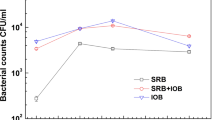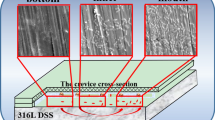Abstract
This study examined the early stages of tarnishing of American Iron Steel Institute (AISI) 304L austenitic stainless steel (SS) condenser tubes in contact with running freshwater from the Tagus River in Spain. The immersion time of the tubes was 569 days. Tarnishing originated by biofouling was assessed using electrochemical impedance spectroscopy (EIS), scanning electron microscopy (SEM), and X-ray photoelectron spectroscopy (XPS) analyses in conjunction with argon ion sputtering. The EIS diagrams showed a semicircle that was better defined as the experimental time increased, indicating the decreasing tarnishing resistance of the immersed specimens. The EIS results were validated using Kramers–Kronig relationships. SEM micrographs of biofouling indicated that the number of microorganisms on the SS surfaces increased with immersion time. According to the XPS spectra, the main elements deposited on the tarnished AISI 304L SS layer were calcium, phosphorus, and nitrogen. A mechanism of biofouling and microbiologically influenced corrosion behavior of AISI 304L SS condenser tubes in freshwater is proposed.















Similar content being viewed by others
References
Pope DH, Soracco RJ, Wilde EW (1982) Studies on biologically induced corrosion in heat exchanger systems at the Savannah River Plant, Aiken, SC. Mater Performance 21:43–50
Stoecker JG (1983) Waterside corrosion of model heat exchanger tubes. In: Corrosion/83, NACE, Houston, Texas, paper no. 245
Pope DH, Duquette DJ, Johannes AH, Wayner PC (1984) Microbiologically influenced corrosion of industrial alloys. Mater Performance 23:14–18
Rao TS, Nair KVK (1998) Microbiologically influenced stress corrosion cracking failure of admiralty brass condenser tubes in a nuclear power plant cooled by freshwater. Corros Sci 40:1821–1836
Abrahan GJ, Kain V, Dey GK (2009) MIC failure of cupronickel condenser tube in fresh water application. Eng Fail Anal 16:934–943
Ibars JR, Polo JL, Moreno DA, Ranninger C, Bastidas JM (2004) An impedance study on admiralty brass dezincification originated by microbiologically influenced corrosion. Biotechnol Bioeng 87:855–862
Moreno DA, Cano E, Ibars JR, Polo JL, Montero F, Bastidas JM (2004) Initial stages of microbiologically influenced tarnishing on titanium after 20 months of immersion in freshwater. Appl Microbiol Biotechnol 64:593–598
Kobrin G (1986) Reflections on microbiologically induced corrosion of stainless steels. In: Dexter SC (ed) Biologically induced corrosion. NACE, Houston, pp 33–46
Ibars JR, Moreno DA, Ranninger C (1992) Microbial corrosion of stainless steels. Microbiol SEM 8:63–75
Pope DH (1986) A study of microbiologically influenced corrosion in nuclear power plants and a practical guide for countermeasures. EPRI NP-4582. Electric Power Research Institute, Palo Alto
Licina GJ (1988) Sourcebook for microbiologically influenced corrosion in nuclear power plants. EPRI NP-5580. Electric Power Research Institute, Palo Alto
Sinha UP, Wolfram JH, Rogers D (1991) Microbially influenced corrosion of stainless steels in nuclear power plants. In: Dowling NJ, Mittleman MW, Danko JC (eds) Microbially influenced corrosion and biodeterioration, vol 4. The University of Tennessee, Knoxville, pp 51–60
Sarró MI, Alemán O, Moreno DA, Roso M, Ranninger C (2004) Influenced of the chemical composition, heat and surface treatment in the biofouling of austenitic stainless steels. Rev Metal 40:21–29
Moreno DA, Ibars JR, Ranninger C (2000) Influence of microstructure on the microbial corrosion behaviour of stainless steels. Rev Metal 36:266–278
Characklis WG, Cooksey KE (1983) Biofilms and microbial fouling. Adv Appl Microbiol 29:93–138
Characklis WG, Marshall KC (1990) Biofilms: a basis for an interdisciplinary approach. In: Characklis WG, Marshall KC (eds) Biofilms. Wiley, New York, pp 3–15
Nekoska G (1989) Cathodic protection to control microbiologically influenced corrosion. In: Licina GJ (ed) Microbial corrosion: 1988 workshop proceedings. EPRI NP-6345. Electric Power Research Institute, Palo Alto, pp C-1–C-13
Nekoska G (1991) Cathodic protection criteria for controlling microbially influenced corrosion power plants. EPRI NP-7312. Electric Power Research Institute, Palo Alto
Neuburg HH (2000) Continuous tube cleaning system. In: Müller-Steinhagen H (ed) Heat exchanger fouling: mitigation and cleaning technologies. Publico, Essen, pp 128–146
EPRI (2009) Nuclear maintenance applications center: heat exchanger maintenance guide. EPRI 1018089. Electric Power Research Institute, Palo Alto
Krzywosz KJ (2006) Nondestructive evaluation: enhanced ID pit sizing for heat exchangers. EPRI 1013454. Electric Power Research Institute, Palo Alto
Mansfeld F, Little B (1991) A technical review of electrochemical techniques applied to microbiologically influenced corrosion. Corros Sci 32:247–272
Buchanan RA, Li P, Zhang X, Dowling NDE, Stansbury EE, Danks JC, White DC (1991) Electrochemical studies of microbiologically influenced corrosion. EPRI NP-7468. Electric Power Research Institute, Palo Alto
Dowling NJE, Stansbury EE, White DC, Borenstein SW, Danko JC (1989). On-line electrochemical monitoring of microbially influence corrosion. In: Microbial corrosion: 1988 workshop proceedings. EPRI NP-6345. Electric Power Research Institute, Palo Alto, pp 5-1/5-19
AWWA–APHA–WEF (1998) Standard methods for the examination of water and wastewater, 20th edn. American Public Health Association, Washington, DC
Rao TS (2009) Microbiologically influenced corrosion: basics and case studies. Corros Rev Special Issue:333–365
Balamurugan P, Hiren Joshi M, Rao TS (2011) Microbial fouling community analysis of the cooling water system of a nuclear test reactor with emphasis on sulphate reducing bacteria. Biofouling 27:967–968
Angell P, Urbanic K (2000) Sulphate-reducing bacterial activity as a parameter to predict localized corrosion of stainless alloys. Corros Sci 42:897–912
Postgate JR (1984) The sulphate-reducing bacteria, second edition. Cambridge University Press, UK
Talyor BF, Oremland RS (1979) Depletion of adenosine triphosphate in Desulfovibrio by oxyanions of group VI elements. Curr Opin Microbiol 3:101–103
Polo JL, Cano E, Bastidas JM (2002) An impedance study on the influence of molybdenum in stainless steels pitting corrosion. J Electroanal Chem 537:183–187
Sheng X, Ting Y-P, Pehkonen SO (2007) The influence of sulphate-reducing bacteria biofilm on the corrosion of stainless steel AISI 316. Corros Sci 49:2159–2176
Xu C, Zhang Y, Chen G, Zhu W (2008) Pitting corrosion behavior of 316L stainless steel in the media of sulphate-reducing and iron-oxidizing bacteria. Mater Charact 59:245–255
Bastidas JM, Polo JL, Torres CL, Cano E (2001) A study on the stability of AISI 316L stainless steel pitting corrosion through its transfer function. Corros Sci 43:269–281
Huttunen-Saarivirta E, Honkanen M, Lepistö T, Kuokkala V-T, Koivisto L, Berg CG (2012) Microbiologically influenced corrosion (MIC) in stainless steel heat exchanger. Appl Surf Sci 258:6512–6526
Ling Y, Chen ZG, Guempl P, Kaesser M (2002) Influence of water pollution on MIC of stainless steel 304L. J Iron Steel Res Int 9:45–48
George RP, Muraleedharan P, Gnanamoorthy JB, Rao TS, Nair KVK (1995) Effect of seasonal changes in water quality on biofouling and corrosion in fresh water systems. In: Tiller AK, Sequeira CAC (eds) Microbial corrosion. The Institute of Materials, London, pp 261–275
Motoda S, Suzuki Y, Shinohara T, Tsujikawa S (1990) The effect of marine fouling on the ennoblement of electrode potential for stainless steels. Corros Sci 31:515–520
Little B, Ray R, Wagner P, Lewandowski Z, Lee WC, Characklis WG, Mansfeld F (1991) Impact of biofouling on the electrochemical behavior of 304 stainless steel in natural seawater. Biofouling 3:45–59
Marconnet C, Dagbert C, Roy M, Féron D (2008) Stainless steel ennoblement in freshwater: from exposure test to mechanisms. Corros Sci 50:2342–2352
Hamilton WA (1985) Sulphate-reducing bacteria and anaerobic corrosion. Annu Rev Microbiol 39:195–217
Kearns JR, Clayton CR, Halada GP, Gillow JB, Francis AJ (1992) The application of XPS to the study of MIC. In: Corrosion/92, NACE, Houston, Texas, paper no. 178
Yuan SJ, Pehkonen SO (2007) Microbiologically influenced corrosion of 304 stainless steel by aerobic Pseudomonas NCIMB 2021 bacteria: AFM and XPS study. Colloid Surf B-Interfaces 59:87–99
Duan J, Hou B, Yu Z (2006) Characteristics of sulfide corrosion products on 316L stainless steel surfaces in the presence of sulfate-reducing bacteria. Mater Sci Eng C-Mater Biol Appl 26:624–629
Briggs D, Seah MP (1990) Practical surface analysis, volume 1: auger and X-ray photoelectron spectroscopy, 2nd edn. Wiley, New York, p 202
Gutiérrez A, López MF, Pérez-Trujillo FJ, Hierro MP, Pedraza F (2000) Effects of Ce, Mo and Si ion implantation on the passive layer composition and high-temperature oxidation behaviour of AISI 304 stainless steel studied by soft X-ray absorption spectroscopy. Surf Interface Anal 30:130–134
Sedriks AJ (1979) Corrosion of stainless steels. Wiley, New York
Landoulsi J, El Kirat K, Richrad C, Féron D, Pulvin S (2008) Enzymatic approach in microbial-influenced corrosion: a review based on stainless steels in natural waters. Environ Sci Technol 42:2233–2242
Szklarska-Smialowska Z (1986) Pitting corrosion of metals. NACE, Houston
Kobrin G (1976) Corrosion by microbiological organisms in natural waters. Mater Performance 7:38–43
Starosvetsky J, Armon R, Groysmam A, Starosvetsky D (1999) Fouling of carbon steel heat exchanger caused by iron bacteria. Mater Performance 1:55–61
Dickinson WH, Caccavo F Jr, Lewandowski Z (1996) The ennoblement of stainless steels by manganic oxide biofouling. Corros Sci 38:1407–1422
Linhardt P (1997) Corrosion of metals in natural waters influenced by manganese oxidizing microorganisms. Biodegradation 8:201–210
George RP, Muraleedharan P, Parvathavarthini N, Khatak HS, Rao TS (2000) Microbiologically influenced corrosion of AISI type 304 stainless steels under fresh water biofilms. Mater Corros 51:213–218
Puckorius PR (1993) Massive utility condenser failure caused by sulfide-producing bacteria. In: Corrosion/83, NACE, Houston, Texas, paper no. 248
Brennenstuhl AM, Gendron TS, Cleland R (1993) Mechanisms of underdeposit corrosion in freshwater cooled austenitic alloy heat exchangers. Corros Sci 35:699–711
Stern M, Geary AL (1957) Electrochemical polarization I. A theoretical analysis of the shape of polarization curves. J Electrochem Soc 104:56–63
Liao J, Fukui H, Urakami T, Morisaki H (2010) Effect of biofilm on ennoblement and localized corrosion of stainless steel in fresh dam-water. Corros Sci 52:1393–1403
Acknowledgments
We thank J. Izquierdo (Iberdrola Generación SA), F. Montero (Iberdrola Generación SA), E. Cano (CENIM–CSIC, Spain), M. Lorenzo (SCI Servicios de Control e Inspección SA), and J. Aparicio (SCI Servicios de Control e Inspección SA) for their help in the chemicals analyses and the XPS measurements. We also thank the employees of the Valdecañas dam and especially the staff who made the in situ experiments possible. This work was supported by the CICYT (Comisión Interministerial de Ciencia y Tecnología of Spain) under Grant MAT97-1043.
Author information
Authors and Affiliations
Corresponding author
Rights and permissions
About this article
Cite this article
Moreno, D.A., Ibars, J.R., Polo, J.L. et al. EIS monitoring study of the early microbiologically influenced corrosion of AISI 304L stainless steel condenser tubes in freshwater. J Solid State Electrochem 18, 377–388 (2014). https://doi.org/10.1007/s10008-014-2390-6
Received:
Revised:
Accepted:
Published:
Issue Date:
DOI: https://doi.org/10.1007/s10008-014-2390-6




